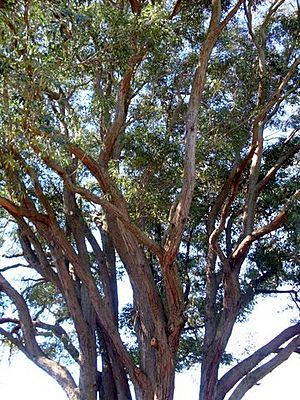Eucalyptus acmenoides facts for kids
Quick facts for kids White mahogany |
|
|---|---|
 |
|
| White mahogany near its southernmost limit of distribution, at Eastwood, Australia | |
| Scientific classification | |
| Genus: |
Eucalyptus
|
| Species: |
acmenoides
|
| Synonyms | |
|
|
The White Mahogany (scientific name: Eucalyptus acmenoides) is a tall tree found only in eastern Australia. It's also sometimes called Barayly. This tree has bark that looks like string and is grey or reddish-brown. Its leaves are shaped like spears, and its buds are oval or spindle-shaped. The fruits are round, like half a sphere. A cool fact about its adult leaves is that the top and bottom sides are different shades of green!
What Does It Look Like?
The White Mahogany is a very tall tree. It can grow over 50 metres (164 ft) (about 164 feet) high. But in dry places, it might only reach half that height. Its bark is thin and looks like strings or fibers. It can be grey or reddish-brown.
Young trees have leaves shaped like eggs or wide spears. These leaves are glossy green and can be up to 120 mm (5 in) (about 4.7 inches) long and 30 mm (1 in) (about 1.2 inches) wide.
Adult leaves are shaped like spears. They are glossy green on top but much lighter underneath. They grow to be 80–120 mm (3–5 in) (3.1-4.7 inches) long and 15–25 mm (0.6–1 in) (0.6-1.0 inches) wide.
The flowers grow in groups, usually with seven to eleven flowers. Each group is on a stem called a peduncle, which is 6–15 mm (0.2–0.6 in) (0.2-0.6 inches) long. Each individual flower sits on a smaller stem called a pedicel, about 2–6 mm (0.08–0.2 in) (0.08-0.24 inches) long.
The flower buds are oval or spindle-shaped. They are 5–7 mm (0.2–0.3 in) (0.2-0.3 inches) long and 3–4 mm (0.1–0.2 in) (0.1-0.2 inches) wide. The cap of the bud, called the operculum, is shaped like a cone or a bird's beak. It's about the same length and width as the base of the flower, which is called the flower cup.
After the flowers, the tree produces fruit. These fruits are round or shaped like half a sphere. They are a type of dry fruit called a capsule. They measure 4–8 mm (0.2–0.3 in) (0.16-0.31 inches) long and 4–7 mm (0.2–0.3 in) (0.16-0.28 inches) wide.
How It Was Named
The White Mahogany was first officially described in 1843. A scientist named Johannes Conrad Schauer gave it the name Eucalyptus acmenoides. He studied a sample collected by Allan Cunningham in a forest in New South Wales in 1817. Schauer published his description in a book called Repertorium Botanices Systematicae.
The second part of its scientific name, acmenoides, means it looks similar to plants in the genus Acmena.
Sometimes, people in parts of Queensland call this tree the yellow stringybark. Even though its bark is rough and a bit stringy, scientists consider it part of the "mahogany" group of eucalyptus trees.
The White Mahogany is one of several trees in the "white mahogany group." Other trees in this group include E. mediocris, E. apothalassica, E. carnea, E. helidonica, E. latisinensis, E. psammitica, and E. umbra.
Where It Grows
White Mahogany trees grow in wet forests and woodlands. They prefer deeper soils that stay moist. You can find them from areas near the Atherton Tableland in Queensland all the way south to Port Jackson in New South Wales.
These trees grow from sea level up to 1,000 m (3,000 ft) (about 3,280 feet) high. They are most common in warm, humid, or tropical climates. In these areas, the average rainfall each year is between 1,000 and 1,700 mm (40 and 70 in) (about 39-67 inches).
Timber Uses
The wood from the White Mahogany tree is very good quality. People use it for many different things. It's strong enough for heavy engineering projects, like building bridges and wharves. It's also used for poles, railway sleepers (the wooden blocks under train tracks), and parts of houses like framing, decking, and floorboards.
The outer part of the wood, called the sapwood, usually doesn't get attacked by a type of beetle called the lyctus borer. The inner part of the wood, called the heartwood, is light and has a pale yellowish-brown color. The wood has a medium and even texture. Its grain is usually uniform, but sometimes it can be interlocked.
This timber is a bit like tallowwood wood, but not as oily. It is also resistant to termites, which are insects that can damage wood. White Mahogany wood is hard, heavy, strong, tough, and lasts a long time. It weighs about 1000 kilograms per cubic meter.
Images for kids
-
A young White Mahogany seedling showing its first leaves, called cotyledons.



